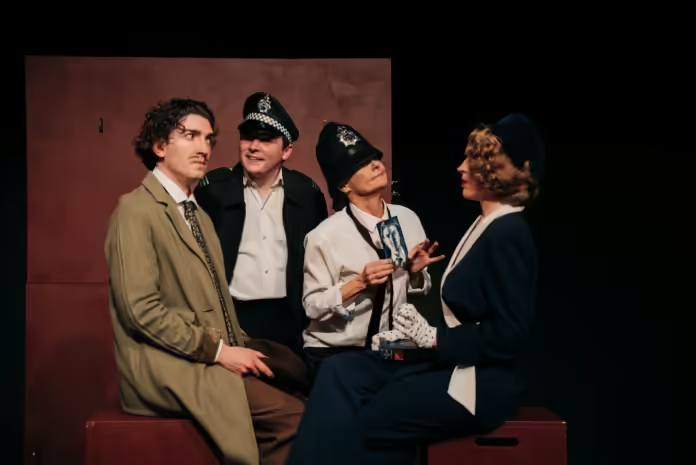What an entertaining romp this was. Mark Wickett, the director, tells us in his programme notes that the company was playing it for laughs, and they certainly succeeded. Clothed in the narrative of a spy thriller and murder mystery, the Theatre Guild’s opening night performance brought lots of laughs and was full of action, snappy dialogue and visual gags. Indeed there were times when it felt more like a circus than anything else. On those occasions we were so drawn into the comedy, wondering what the next imaginative sight gag would be, that it almost subsumed the plot itself.
That’s not to say the plot wasn’t clear. The mystery followed its intended course from the murder in London to Scotland where the foreign forces of evil were lurking and were ultimately challenged by our hero.
There was no dull moment and that was due to a fast-moving script, skilful directorial interpretation and fine performances by all four actors. It is often held that this play has four actors playing over 130 parts between them. Perhaps they do get to that number, but if not, they come awfully close.
Thomas Midena, the only actor to play just the one role, was well suited to his character, Hannay. Principally, he was the ‘straight’ character, distinguished, calm and steady, surrounded by madcap action. As Hannay, he was credible and not the comic caricature that the clowns portrayed. The contrast he drew increased both the interest and the humour.
Imogen Deller-Evans provided her three characters, the mysterious Annabella, the mousy Scottish farmer’s wife, Margaret, and the sophisticated Pamela, with clear distinction. She had decided presence with each. Further, she brought a fine sense of comedy to a number of scenes, perhaps best exemplified by the very funny, if unintentionally sensual, removal of her stockings while handcuffed to Hannay.
Emily Branford and Maxwell Whigham excelled as the clowns – and very many other entertaining characters. Their energy was relentless. Their timing was so exact, and the character changes often so swift, that those scenes sped by. One of the most frantic and memorable was Whigham’s hat-swivelling routine at the station when he was a porter, then a policeman, then a porter and so on, each iteration within seconds of the last. Branford had similar ultra-fast changes of character and style. They worked very well with each other, their over-drawn characters and crazy antics supporting rather than overshadowing one another.
Indeed, all four cast members worked effectively as an ensemble, and moved flawlessly around the stage areas and also around and through the audience. The Little Theatre lent itself very well to the rapid action.
That action was underlaid with timely, often amusing on-stage sound effects and occasional commentary by Angela Short, playing the announcer and Foley Artist from her lofty perch on the balcony above the main stage.
The set was spartan – a black back cloth with a central focus of a small coloured flat, along with a few handy props, chiefly small blocks and a light weight door and window frame. The cast and crew deftly manipulated the blocks to represent various objects and if there was a little delay in that work, such as in the construction of the automobile, the actors made even that into a comic sketch.
This was a good deal of fun, and thoroughly appreciated by the well filled house on opening night.



